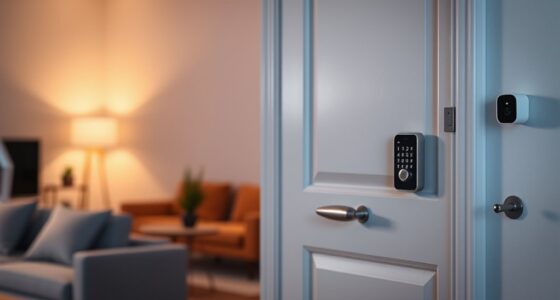Many home security systems can be compromised, particularly those that utilize wireless technology such as ADT, SimpliSafe, Cove, and Eufy. These systems are at risk due to issues like weak passwords, the absence of two-factor authentication, and vulnerability to jamming attacks. Notable breaches, like the 2019 Ring incident, underscore the severe risks involved. Abnormal camera movements or unauthorized access to signals could indicate a security breach. Safeguarding your home necessitates recognizing these weaknesses and implementing stronger passwords along with regular software updates. For guidance on enhancing the security of your system, continue reading for valuable insights.
Key Takeaways
- ADT systems have vulnerabilities, particularly in certain DVR models that can be exploited by hackers.
- SimpliSafe demonstrated susceptibility to jamming attacks, allowing unauthorized access to security features.
- Ring cameras are at risk due to backend flaws that permit unauthorized control and access.
- Cove and Eufy scored poorly for replay disarm resistance, making them vulnerable to hacking attempts.
Overview of Home Security Vulnerabilities
Many homeowners don't realize that their security systems can be vulnerable to various hacking methods, putting their safety at risk. Wireless security systems, while convenient, often depend on Bluetooth and Wi-Fi connections that hackers can exploit.
For instance, if you're using passwords of only eight characters or less, you're making it easy for attackers to gain access to your devices. As highlighted in recent discussions about cybersecurity measures, the significance of robust protection can't be overstated.
Many systems lack robust two-factor authentication and strong encryption, which further amplifies these vulnerabilities. Without these security measures, unauthorized access becomes a significant risk, leading to potential privacy violations.
Even popular DIY security systems like Cove and Eufy have been criticized for their weaknesses, such as jamming and replay disarm attacks.
High-profile incidents, like the 2019 Ring data breach revealing over 3,000 user credentials, serve as stark reminders of the real-world dangers associated with these vulnerabilities.
If you rely solely on a basic monitoring service, you mightn't be adequately protected. It's essential to stay informed about the vulnerabilities in your security system to guarantee your home and privacy remain safe from hacking threats.
Common Hacking Techniques

Numerous hacking techniques pose significant threats to home security systems, making it essential for homeowners to understand how these attacks work.
One common method is phishing, where attackers deceive you into revealing your login credentials.
Brute-force attacks systematically guess your passwords, exploiting any weaknesses in your security.
Man-in-the-middle attacks can intercept communications between your security system and its monitoring service, allowing hackers to manipulate data or gain unauthorized access.
Meanwhile, jamming attacks disrupt signals from your wireless devices, preventing alarms from triggering during a break-in.
Replay attacks capture and resend legitimate disarm signals, allowing unauthorized entry if your system isn't well-protected against such exploits.
Additionally, credential stuffing uses stolen username and password combinations from data breaches to access multiple accounts. This tactic is particularly effective against systems lacking strong passwords or two-factor authentication.
To mitigate these risks, always use strong passwords and enable two-factor authentication whenever possible.
Signs Your System May Be Hacked

If you notice unusual behavior from your security cameras, it could be a sign that your system has been hacked. A hacker may gain unauthorized access, compromising your home security and privacy. Here are some signs to watch for:
| Signs | What It Could Mean |
|---|---|
| Unusual camera movements | Cameras may be controlled remotely |
| Unexpected activation of LED lights | Indicates unauthorized access |
| Inability to access accounts | Possible security breach |
| Increased data usage | Unexplained streaming of video feed |
| Strange noises from cameras | May signal hacking attempts |
Being vigilant is important. If you notice any of these signs, it's vital to act quickly. Check your authentication methods for connected devices, and consider resetting your wireless security systems. Regularly updating passwords and monitoring your video feed can help maintain your security. Don't ignore these warning signs, as they can be the difference between a secure home and a vulnerable one. Always prioritize your home security to protect your family and belongings.
Specific Systems at Risk

Certain home security systems have specific vulnerabilities that can leave you exposed to potential breaches. For instance, ADT's wireless home security systems, particularly certain DVR models, have faced vulnerabilities, though their Pulse cameras offer better resistance.
Additionally, keeping informed about current security trends and issues is crucial for homeowners. SimpliSafe demonstrated the risk of jamming attacks in 2019, showing how easily a low-cost device can compromise security.
Ring cameras are also at risk due to backend flaws, allowing unauthorized access by exposing unknown IP addresses. If you're using Cove or Eufy systems, be aware that they're rated Poor for replay disarm resistance, which means a hacker needs to be close to your key fob or keypad to exploit this vulnerability.
Moreover, many DIY home security systems, such as those from Abode and Cove, are susceptible to jamming attacks, with only half of tested models effectively resisting these exploits.
While professional monitoring adds a layer of security, it's critical to recognize that without proper security practices, getting hacked remains a possibility. Always verify that your wireless security cameras and other devices are up to date with the latest authentication requirements to minimize risks.
Preventive Measures for Security Systems

To safeguard your home security systems from vulnerabilities, implementing effective preventive measures is essential. Start by creating strong passwords for all your devices, changing them regularly to enhance their security. Nearly 50% of Americans use passwords of 8 characters or less, making them an easy target.
Utilize two-factor authentication (2FA) for an extra layer of protection against unauthorized access. Don't forget to regularly update your firmware and software to patch vulnerabilities, ideally during routine tasks like changing smoke detector batteries.
Secure your home network by enabling encryption protocols like WPA2 or WPA3, which help protect your data privacy and prevent unauthorized access.
Lastly, make it a habit to monitor camera footage for unusual activity and log IP addresses to spot potential breaches.
Here's a quick reference table:
| Measure | Importance |
|---|---|
| Strong Passwords | Prevents easy hacking |
| Two-Factor Authentication | Adds extra security |
| Firmware Updates | Patches vulnerabilities |
| WPA2/WPA3 | Secures home network |
| Monitor Camera Footage | Detects unauthorized access |
Recent Breaches and Incidents

Recent breaches in home security systems have exposed serious vulnerabilities, leaving many users at risk of unauthorized access and compromise.
In 2019, Ring experienced a significant data breach that affected over 3,000 users, revealing weaknesses in their handling of user credentials. Similarly, SimpliSafe fell victim to hacking when a $2 dongle was used to bypass security measures, emphasizing how accessible hacking tools can threaten your home security.
The increasing AI advancements raise significant privacy concerns in security systems, highlighting the need for robust ethical frameworks to protect user data.
Insider threats also pose a risk, as seen with ADT when a former installer retained unauthorized access to systems. Additionally, Cove and Eufy security systems received poor ratings for their replay disarm resistance, making them susceptible to replay attacks that can undermine system integrity.
These incidents highlight that while home security systems can offer protection, they're not foolproof.
To safeguard your home, it's essential to stay informed about these vulnerabilities and take proactive measures. Regularly update your system, change passwords, and consider using two-factor authentication where available. Protect your system against potential breaches by choosing reliable security systems and understanding the risks that come with them.
Manufacturer Responses to Vulnerabilities

In light of the vulnerabilities exposed by recent breaches, manufacturers are taking steps to enhance the security of their home security systems. Companies like Eufy are planning a software update to address jamming vulnerabilities, while Cove is considering implementing encrypted sensors in future versions.
These manufacturer responses reflect a growing awareness of security flaws within their products. The importance of quality assurance in software development is becoming increasingly evident as these companies endeavor to improve their systems.
Ring has introduced some safeguards in reaction to identified vulnerabilities, though details on future updates remain vague. SimpliSafe, on the other hand, actively refines its algorithms to better detect jamming attacks and has committed to improving overall security.
Such efforts indicate an urgent need for ongoing evaluation of security features by security companies, as expert insights emphasize the importance of addressing system vulnerabilities promptly.
As more consumers become aware of these issues, the pressure on manufacturers to enhance security measures continues to rise. By prioritizing encryption and regular software updates, these companies aim to fortify their systems against potential threats, ensuring that you can feel safe and secure in your home.
Expert Recommendations for Protection

Implementing strong, unique passwords for all your devices is essential to safeguarding your home security system from potential breaches. A considerable number of individuals use weak passwords, making them easy targets for hackers. To strengthen your security measures, consider the following recommendations:
- Use unique passwords for each device and account.
- Enable two-factor authentication (2FA) to add an extra layer of security.
- Regularly update firmware on your devices to patch vulnerabilities.
- Choose reputable brands that offer end-to-end encryption for their security systems.
Additionally, verify your Wi-Fi router is secure, as it can be a gateway for unauthorized access.
Air purifiers can help improve indoor air quality, which can contribute to a healthier living environment.By actively monitoring your security systems and reinforcing these practices, you'll greatly reduce your risk of being hacked. Implementing these expert recommendations can help protect your home and give you peace of mind.
Frequently Asked Questions
Is There a Home Security System That Cannot Be Hacked?
There's no home security system that's completely unhackable. While some systems offer better protection, all internet-connected devices have vulnerabilities. Staying vigilant and regularly updating your security measures is key to minimizing risks.
What 5 Home Security Systems Are Vulnerable to Hackers?
When considering vulnerabilities, you've got to recognize that systems like ADT, SimpliSafe, Cove, Eufy, and Ring have been reported as susceptible to various hacking methods, putting your home security at risk if not properly managed.
Has Simplisafe Been Hacked?
Yes, SimpliSafe experienced a hacking incident in 2019 through a jamming attack. However, they've since improved their security measures, making it harder for unauthorized access while continuing to enhance their system's resilience against potential threats.
Can Ring Home Security Be Hacked?
Imagine a fortress with a creaky door; Ring home security isn't immune to breaches. Yes, it can be hacked, especially if you don't use strong passwords or two-factor authentication. Stay vigilant and secure your home!
Is It Safe to Buy Home Security System from Any Retailer?
When looking to buy home security system, it’s important to choose a reputable retailer. Ensure the retailer offers quality products and reliable customer service. Research the retailer’s reputation and read customer reviews before making a purchase. Protect your home and family with a trustworthy security system.
Conclusion
In today's tech-savvy world, it's easy to think your home security system is foolproof, but vulnerabilities exist.
Imagine coming home to find your door ajar, realizing the very system you trusted was compromised.
Don't wait for a breach to take action—implement the preventive measures discussed.
By staying informed and proactive, you can fortify your home against hackers and keep your loved ones safe.
Remember, peace of mind is worth the effort.









